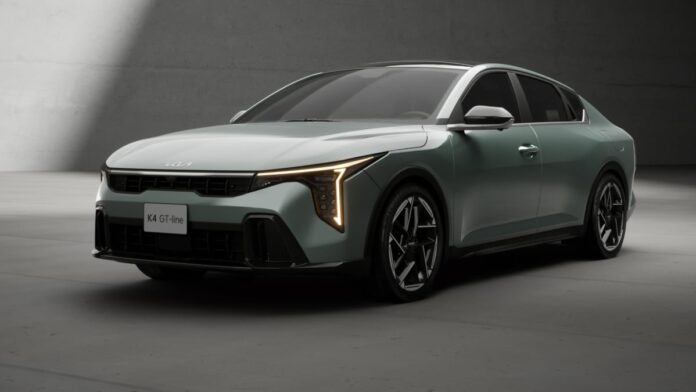[ad_1]
Goodbye Cerato, hello K4. Kia’s new small car is larger and packed with new tech – but the sporty GT has been replaced by a less powerful GT-Line.
The Kia Cerato name will be axed in Australia next year, replaced by an all-new model known as the 2025 Kia K4, formally unveiled in the US overnight.
It has been shown first as a four-door sedan – with a five-door hatchback expected to follow at a later date – with Australian showroom arrivals due between January and March 2025, pending any delays.
The switch to K4 consolidates Kia’s global small-car line-up – which sees Australia’s Cerato sold as the K3 or Forte overseas, and a related vehicle badged Ceed sold in Europe – under one model name as sales of small car slow.
Once the final Kia Ceratos leave showrooms in 2025, the badge will have been fitted to nearly 200,000 hatchbacks, sedans and coupes sold in Australia since 2004.
The new Kia K4 is expected to be built in Mexico for global markets, and is closely related to the Hyundai i30 Sedan on sale in Australia since late 2020.
It is available with non-turbo and turbocharged four-cylinder petrol engines – including a GT-Line to replace the GT, although with less power than before – but there is no mention at this stage of a hybrid.
The K4 draws styling cues from other new Kias – including the EV5 electric SUV – with futuristic T-shaped LED headlights, C-shaped LED tail-lights connected across the tailgate, and pronounced creases over the wheel arches.
It is available in a GT-Line specification, with sportier front and rear bumpers, 18-inch alloy wheels, black mirror caps and side skirts, satin chrome window trim, LED projector headlights, and LED fog lights.
The K4 sedan measures 4709mm long and 1849mm wide – 68mm longer and 49mm wider than its predecessor, and identical in length but 24mm wider than the i30 Sedan, which rides on a 2720mm wheelbase expected to be shared with the Kia.
Kia US claims “class-leading” rear legroom and headroom of 965mm and 947mm respectively – despite the sloping roofline – while there is 413L of claimed space under the boot lid, which is down from the 433L quoted by the previous model in the US.
In Australia the current Cerato sedan claims 502L of boot space, suggesting it is to different measuring standards than what is used in the US.
Inside, there are dual widescreen displays for the instruments and infotainment, running Hyundai and Kia’s latest ‘ccNC’ infotainment software with wireless Apple CarPlay and Android Auto, over-the-air updates and satellite navigation.
These screens are joined by a third, smaller display for key air-conditioning functions – though Kia has kept traditional toggle switches under the touchscreen for air temperature and fan speed, as well as shortcut buttons for infotainment menus.
Included in US models is a ‘Hey Kia’ voice assistant – which the South Korean car giant says will gain artificial-intelligence tech at a later date – plus support for the Kia Connect smartphone companion app, and a phone-based key for compatible Apple and Samsung phones.
The seats are available in grey, green, black or white – depending on the model – with heated and ventilated front seats with driver’s side memory offered on top-of-the-range models, plus a sunroof and Harman Kardon premium sound system.
Unique to the GT-Line is a three-spoke steering wheel with metal-look shift paddles, different dashboard trim, and exclusive seat upholstery options.
Powering most K4s in the US is a 2.0-litre non-turbo four-cylinder petrol engine sending 110kW and 179Nm to the front wheels through a continously-variable automatic transmission.
This engine and transmission combination was already standard in the US, but in Australia the current Cerato uses a 2.0-litre petrol engine with 112kW and 192Nm, and a six-speed torque-converter auto.
Meanwhile the K4 GT-Line is available with a 1.6-litre turbocharged four-cylinder petrol engine developing 142kW and 264Nm, matched with an eight-speed torque-converter automatic transmission – replacing the current GT’s seven-speed dual-clutch auto – and front-wheel drive.
It represents an 8kW power cut from the current Cerato GT’s 150kW – as well as a 1Nm drop on paper, though it appears to be a quirk of how the output is rounded to reach the 195lb-ft torque figure in the US, and then to Nm, rather than a genuine change in output.
In the US, the GT-Line – available with both engines – gains multi-link independent rear suspension in place of the regular torsion-beam design, plus sports pedal covers and paddle shifters.
Kia says an acoustic windscreen has been fitted to reduce noise, as well as “acoustic tyres” on K4 variants with 18-inch wheels.
The safety suite has seen a boost with a more advanced autonomous emergency braking system capable of preventing head-on collisions, and in intersections, and traffic sign recognition with an overspeed warning that beeps when the detected speed limit has been exceeded.
Blind-spot monitoring can now steer or brake to avoid a collision, while side parking sensors (in addition to front and rear), blind-spot cameras, and a 360-degree top-down camera are all now available.
Other safety features shared with the Cerato include adaptive cruise control (with stop and go), lane-keep assist, lane centring assist, and rear cross-traffic alert.
There are now eight airbags in US models, including rear-side torso airbags for the first time.
The 2025 Kia K4 is due in Australian showrooms in the first quarter of 2025 (January to March), first as a sedan. Prices, features and the model range are due to be announced closer to launch.
[ad_2]
Source link
















